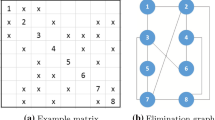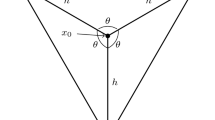Abstract
The numerical performance of the state-of-the-art simplex based optimizers is good. At the same time, a newly arising LP problem can cause troubles still. This is exactly what happened in the Summer of 1992. The appearance of a hard LP problem motivated the development of the idea of a numerically exact implementation of the simplex method. It is based on a super register (SR) capable of accumulating inner products with arbitrary accuracy. The necessary operations of SR that require assembly level programming are introduced. Vectors of super registers would require prohibitively much memory. Therefore, a single-SR technique is proposed that entails the reorganization of parts of the simplex method. The ideas have been implemented in the MILP LP optimizer. Experiences show that solution speed decreases by 30–50 percent but robustness increases which may be important in case of critical problems. A framework is outlined for a system where the advantages of the traditional and the SR technique can co-operate efficiently.
Similar content being viewed by others
References
M. Benichou, J.M. Gauthier, G. Hentges and G. Ribiere, The efficient solution of large scale linear programming problems, Math. Progr. 13(1977)280–322.
D.M. Gay, Electronic mail distribution of linear programming test problems, COAL Newsletter (1985)10–12.
J.E. Kalan, Machine inspired enhancements of the simplex algorithm, Technical Report CS75001-R, Virginia Polytechnic Institute, Blacksburg, VA (1975).
I. Maros, A Three-Parameter Arithmetic (TPA), MTA SZTAKI Working Paper, MO/85 (April, 1989).
I. Maros, MILP linear programming optimizer for personal computers under DOS, Research Report, MTA SZTAKI, Budapest, 41/1991 (1991).
W. Orchard-Hays,Advanced linear Programming Computing Techniques (McGraw-Hill, 1968).
D. Shanno, private communications (1992).
U. Suhl and L.M. Suhl, Computing sparse LU factorization for large-scale linear programming bases, ORSA J. Comp. 2(1990)325–335.
P. Wolfe, Error in the solution of linear programming problems, in:Error in Digital Computations, ed. L.B. Rall, Vol. II (Wiley, 1965) pp. 271–284.
J.H. Wilkinson,The Algebraic Eigenvalue Problem (Clarendon Press, 1965).
Author information
Authors and Affiliations
Additional information
This research was partly supported by Hungarian Research Fund OTKA 2587.
Rights and permissions
About this article
Cite this article
Maros, I., Mészáros, C. A numerically exact implementation of the simplex method. Ann Oper Res 58, 1–17 (1995). https://doi.org/10.1007/BF02032307
Issue Date:
DOI: https://doi.org/10.1007/BF02032307




